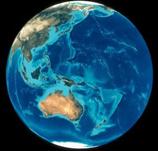Offshore & Deep Water Environments
 Away from land, the open sea divides into two main regions, the continental shelves (pale blue on the globe), where water is less than 200m deep, and the deep abyssal plains (dark blue) of the ocean floor, anything from 2,000m to 6,000m deep.
Away from land, the open sea divides into two main regions, the continental shelves (pale blue on the globe), where water is less than 200m deep, and the deep abyssal plains (dark blue) of the ocean floor, anything from 2,000m to 6,000m deep. Between the two is the continental slope.
Continental Shelf
The sediment deposited here is mainly material eroded from nearby land, together with organic remains such as broken sea shells. Sands may be swept along and deposited by tidal currents, whilst finer mud settles out in calmer (deeper or more sheltered) water.
Abyssal Plain
On the deep ocean floor, sediment deposition is usually very slow indeed, as the only sediments to reach this far from land are wind-borne dust and volcanic ash. However, plankton in the surface waters of the ocean provide a gentle “rain” of organic remains; the microscopic shells of these organisms form fine-grained oozes that gradually settle out on the deep sea floor.Towards the poles, “dropstones” – material melted out of icebergs - also add to the deep sea sediments.







